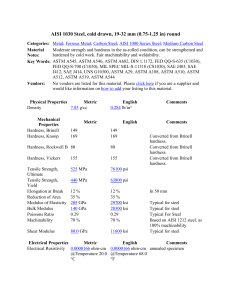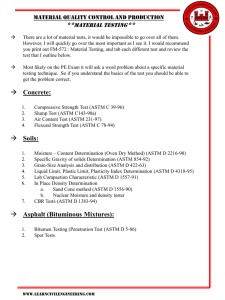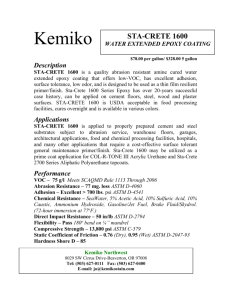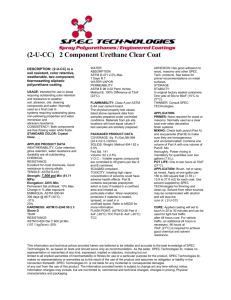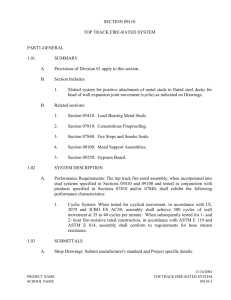Section #12 35 53.13 - Steel Laboratory Casework
advertisement
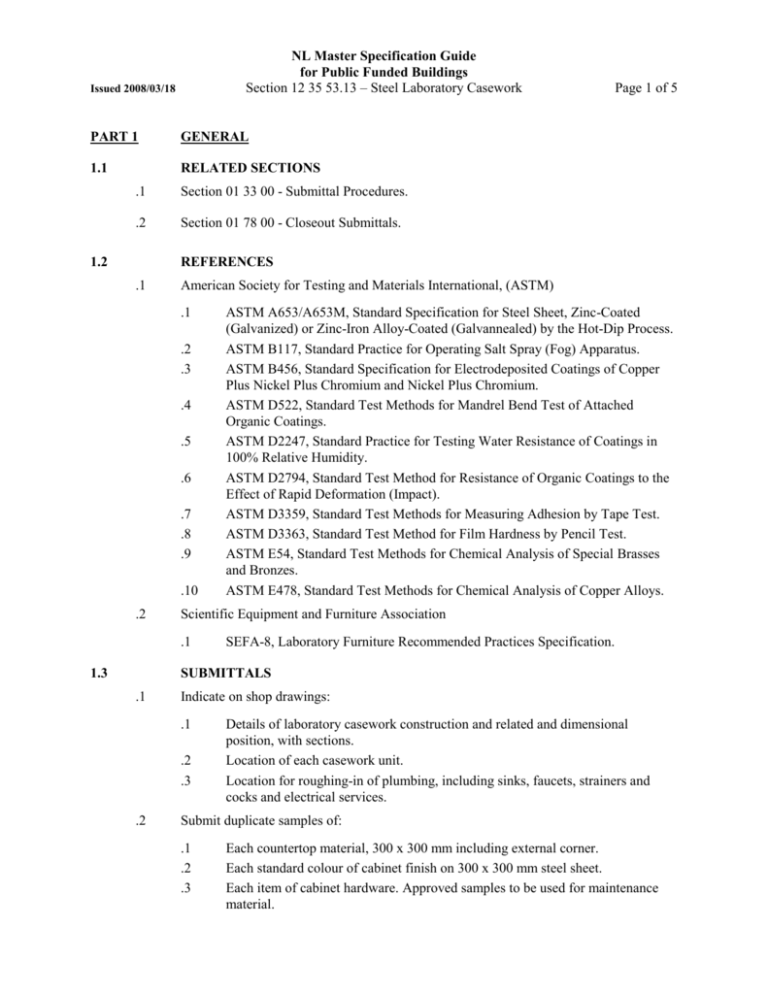
NL Master Specification Guide for Public Funded Buildings Section 12 35 53.13 – Steel Laboratory Casework Issued 2008/03/18 PART 1 GENERAL 1.1 RELATED SECTIONS .1 Section 01 33 00 - Submittal Procedures. .2 Section 01 78 00 - Closeout Submittals. 1.2 Page 1 of 5 REFERENCES .1 American Society for Testing and Materials International, (ASTM) .1 .2 .3 .4 .5 .6 .7 .8 .9 .10 .2 Scientific Equipment and Furniture Association .1 1.3 ASTM A653/A653M, Standard Specification for Steel Sheet, Zinc-Coated (Galvanized) or Zinc-Iron Alloy-Coated (Galvannealed) by the Hot-Dip Process. ASTM B117, Standard Practice for Operating Salt Spray (Fog) Apparatus. ASTM B456, Standard Specification for Electrodeposited Coatings of Copper Plus Nickel Plus Chromium and Nickel Plus Chromium. ASTM D522, Standard Test Methods for Mandrel Bend Test of Attached Organic Coatings. ASTM D2247, Standard Practice for Testing Water Resistance of Coatings in 100% Relative Humidity. ASTM D2794, Standard Test Method for Resistance of Organic Coatings to the Effect of Rapid Deformation (Impact). ASTM D3359, Standard Test Methods for Measuring Adhesion by Tape Test. ASTM D3363, Standard Test Method for Film Hardness by Pencil Test. ASTM E54, Standard Test Methods for Chemical Analysis of Special Brasses and Bronzes. ASTM E478, Standard Test Methods for Chemical Analysis of Copper Alloys. SEFA-8, Laboratory Furniture Recommended Practices Specification. SUBMITTALS .1 Indicate on shop drawings: .1 .2 .3 .2 Details of laboratory casework construction and related and dimensional position, with sections. Location of each casework unit. Location for roughing-in of plumbing, including sinks, faucets, strainers and cocks and electrical services. Submit duplicate samples of: .1 .2 .3 Each countertop material, 300 x 300 mm including external corner. Each standard colour of cabinet finish on 300 x 300 mm steel sheet. Each item of cabinet hardware. Approved samples to be used for maintenance material. NL Master Specification Guide for Public Funded Buildings Issued 2008/03/18 Section 12 35 53.13 – Steel Laboratory Casework PART 2 PRODUCTS 2.1 Page 2 of 5 MATERIALS .1 Galvanized steel sheet: commercial quality to ASTM A653 with Z275 zinc coating. .2 Glazing: to Section 08 80 50 - Glazing. .3 Sealants: to Section 07 92 00 - Joint Sealants. 2.2 COUNTERTOP MATERIALS .1 Epoxy Resin: 100% moulded solid epoxy resin compound with a uniform mixture through entire thickness. Minimum thickness to be 25 mm. Color to be satin black, dished construction. .2 Exposed edges to be finished with applied marine edge to a height of 12.7 mm. .3 Backsplashes to be 19 mm thick solid epoxy resin to heights indicated. Secure backsplash to back edge of countertop with black epoxy adhesive formulated for use with epoxy resin countertops. .4 Epoxy finished surfaces to conform to following minimum requirements: .1 .2 .3 .4 .5 .6 .7 .8 .9 .10 .11 2.3 Tensile strength: 70 MPa. Flexural strength: 110 MPa. Compressive strength: 250 MPa. Hardness: 100 Rockwell. Water absorption: 0.1% Good flexibility, hard abrasion, impact and thermal shock resistant. Resist immersion in water, and heat up to 100 degrees. Resistance against alkaline substances, detergents and coolants. Resistance to acid fumes, acid solutions, greases and oils. Resistance to wide range of corrosive chemicals and solvents. Will not support mould or fungus growth. COUNTERTOP FABRICATION .1 Fabricate laboratory countertops and backsplashes as indicated. .2 Fabricate countertop and backsplashes sections in as long a length as practicable. .3 Cut holes for fittings, accessories, and equipment. .4 Round or chamfer exposed edges and corners of cutouts. .5 Finish exposed edges and surfaces in same manner as specified for working surface of countertop material. .6 Make allowances around periphery and where fixed objects pass through or project into countertop material to permit normal movement without restriction. .7 Joints: field welded or mechanical watertight. NL Master Specification Guide for Public Funded Buildings Issued 2008/03/18 Section 12 35 53.13 – Steel Laboratory Casework 2.4 LABORATORY SINKS Page 3 of 5 .1 Equip laboratory sinks with tailpieces, cross strainer, plug and overflow unless otherwise indicated. .2 Provide standing overflow, when in position, 25 mm below flood level of sink. Include perforated over-flow guard with top 12 mm below flood level. .3 Locate waste outlets where indicated. .4 Stainless steel sinks: to ASTM E54 and ASTM E478, 1.4 mm, type 316 stainless steel, welded construction without solder or fill, exposed surface polished No. 4 finish, 406 x 457 x 254 mm deep. .1 .2 2.5 Use under mount stainless steel sinks. Provide clips c/w machine screws and inserts for installation in solid surface countertops as per manufacturers recommendations. Apply sound deadening material undercoating to sinks. CABINET HARDWARE .1 Flush Finger Pulls: provide handles for drawers and hinged doors in chrome plated finish set flush within thickness of doors and drawers. .2 Door Catches: adjustable zinc-plated, spring-loaded, nylon roller. .3 Strike Plates: fabricated of stainless steel, designed to be secured to cabinet without twisting. .4 Door Hinges: five knuckle-type barrel door hinges of 14 Ga steel screwed into door and fastened to cabinet side stile. .5 Locks – Base Cabinets: nickel plated cam lock with 5 disc tumbler and removable core, for base cabinets locks and drawers. .6 Locks – Sliding Glass Doors: chrome plated slip-on ratchet type locks. 2.6 FABRICATION .1 Fabricate steel laboratory casework to details. .2 Align end panels, top rails, bottoms and vertical posts, at intersections in same plane, without overlap. .3 Grind exposed welds flush and smooth , burnish to match adjacent surfaces. .4 Provide 2 mm thick metal for tapping strips, gussets, drawer runners and hinge reinforcements. .5 Use 1.5 mm thick metal for cabinet top rails, hanging brackets, frame and base. .6 Use 1.2 mm thick metal for cabinet door outer pan and slide support, cross rails, cabinet fronts, scribe strips and fillers. NL Master Specification Guide for Public Funded Buildings Issued 2008/03/18 Section 12 35 53.13 – Steel Laboratory Casework Page 4 of 5 .7 Use 0.9 mm thick metal for drawer and door inner panels, drawer bodies and back panels to cabinets. 2.7 CABINETS .1 Construct cabinet bodies of sheet metal, flanged and returned at exposed gables to receive flush mounted drawer fronts and doors. .2 Flange and set back top rails and bottom panels. .3 At base cabinets provide 38 mm long levelling screw for adjusting to floor variations, in gussets and accessible through plugged openings in bottom. .4 Provide removable backs, knee space panels or access doors where piping or wiring occur. 2.8 DOORS .1 Fabricate doors of double pan construction, 16 mm thick, telescoped inner pan into outer pan with exposed vertical edge formed into channel shape having returned lip over inner pan, offset to receive lip. .2 Provide reinforcement for hardware attachment to inner pan and conceal. Install hardware. .3 Bevel inside edge of cutout in front panel of glass door. .4 Set glass in continuous rubber gasket between panels. 2.9 DRAWERS .1 Fabricate drawer fronts of double pan construction, 16 mm thick, telescoped inner pan with exposed vertical edge formed into channel shape having return lip over inner pan, offset to receive lip. .2 Weld drawer bodies to front through flanges on sides and bottom, and back through flanges at rear. .3 Extend flanges outward or downward, top of side and back rolled. Cove corners to 12 mm radius. .4 Provide reinforcements for hardware and install finish hardware. 2.10 SHELVES .1 Form shelves of steel sheet with front and rear edges flanged down 19 mm and hemmed back at 30 degrees to underside of shelf. .2 Support shelves with shelf clips inserted in slots in front stile and in formed channel in back. 2.11 FINISHING .1 Grind and polish spot weld marks from exposed surfaces. NL Master Specification Guide for Public Funded Buildings Issued 2008/03/18 Section 12 35 53.13 – Steel Laboratory Casework Page 5 of 5 .2 Apply semigloss, thermosetting epoxy enamel finish to SEFA 8. The final paint coating to have a minimum film thickness of 0.031 mm (1.2 mils) on all exposed parts and a minimum of 0.025 mm (1.0 mils) on all other surfaces. Colors selected from manufacturer’s color range. .3 Epoxy enamel paint finish to conform to following minimum requirements: .1 .2 .3 .4 .5 .6 Pencil Hardness: to ASTM D3363, 4H minimum. Humidity Resistance: to ASTM D2247, no visible effect. Salt Spray Resistance: to ASTM B117, no visible effect. Adhesion: to ASTM D3359, Method B, minimum 100 squares retain finish. Adhesion and Flexibility: to ASTM D522, no peeling or cracking of finish. Impact Resistance: to ASTM D2794, no cracking of finish or metal exposure. PART 3 EXECUTION 3.1 INSTALLATION .1 Install laboratory casework plumb with countertops level to 1.5 mm in 3 m. .2 Level base cabinets by adjusting levelling screws. .3 Fit closure strips and scribe to irregularities of adjacent surfaces, maximum gap opening 0.5 mm. .4 Support wall cabinets by bolting directly to wall. .5 Bolt adjoining cabinets together, maximum width of joint 1 mm. .6 Apply small bead of sealant at junction of countertop and adjacent wall finish. .7 After installation, adjust operating hardware. 3.2 CLEANING .1 On completion, touch up marred or abraded finished surfaces. .2 Wipe down surfaces to remove fingerprints and markings and leave in clean condition. 3.3 COMMISSIONING .1 Instruct Owner in operation, adjustments, cleaning and maintenance. END OF SECTION
